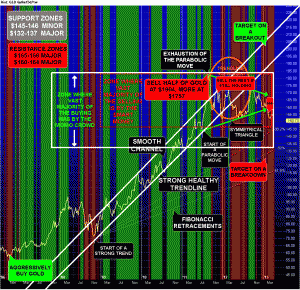
Recently I have received a lot of emails from clients and potential investors asking questions about gold and silver. In the last week the email and call volume has been through the roof. Everyone has had the same questions, “Why is gold down on news of North Korea warning that its military has been cleared to wage a nuclear attack against the United States?”
Similarly, many people emailed me when Eurozone member Cyprus proposed a quite sizable tax on bank deposits, which led to another proposal regarding partial confiscation of private property. Moreover, news broke that central banks across the world bought more than $3 billion in gold in 2013.
Nuclear Missiles
Although it is not very likely that North Korea would actually act upon their recent nuclear threats, we should nevertheless remain vigilant. North Korea’s new inexperienced young leader Kim Jong-Un is attempting to prove to the North Korean people that he strong leader; thus, we have to take into account that this inexperienced leader might in fact follow up on his threats. Considering this volatile political situation, the price for gold should have spiked, but it did not.
Cyprus
Cyprus had to eventually abandon its plan to impose taxes on bank deposits as this proposal was widely opposed. Again, the Cypriot government did not just seek to impose a tax on interests, but on all deposits. This would have led to the confiscation of private property without any compensation. Yet, Cyprus managed to impose strict capital control regulations. Originally, people were able withdraw a maximum of 300 euros per day from the bank and they could not take more than 1000 euros out of the country. Furthermore, overseas credit card transactions were not allowed to exceed 5000 euros per month.
Even though Cyprus’ capital control regulations have been eased, they still remain onerous. Cypriots with large deposits are likely to lose a lot of money if the value of Euro drops and they are unable to get a hold of their financial assets. One would think that under these circumstances, people would want to protect their money by investing in gold, but they did not.
Central Banks
As mentioned above, central banks world wide bought $3 billion worth of gold in just the first two months of 2013, (according to UBS data): South Korea bought 20 metric tons, Russia purchased 19.2 metric tons, Kazakhstan accumulated 6.6 metric tons, Indonesia invested in 1.9 metric tons, Bosnia bought 1 metric ton, and Azerbaijan purchased 2 metric tons. Such a massive run on gold by numerous central banks should have caused its price to rise to $1900 but it did not.
So What Has Happened To Gold?
It is actually not that confusing if you understand complex computer algorithms. However, since most of us do not, let me explain. We have been on a down sloping trend line since October 2012. This is the reason why I have urged my clients to look into other areas of the precious metal market. Basically, the trend line told the algorithms to sell. Yet, since an algorithm cannot take into account current events like central banks’ sudden accumulation of gold, Cyprus’ capital control policies or North Korea’s nuclear threats, it just sells when it hits a certain number, as the algorithm is programmed to do.
In addition, the people who panicked were the ones who invested in gold for the wrong reasons. I like to call these types of investors “trend feeders.” The feeders do not really understand what they are doing, but since everybody else is doing it, they do it, too. These buyers get disappointed because they do not understand that gold is a long-term investment and they typically seek to obtain a quick turnaround. These buyers sold their gold after a weak bounce in February, which then led to the large sell-off we just witnessed.
What To Do Now
Long story short, you need to decide if you are a trader or a long-term investor. If you are a long-term investor, it is time to buy and hold. If you are a trader you will see it is time to bargain hunt. We saw the bounce up off the magic $1,320 number, which is what I personally was looking for.
Most of you know that I am not a fan of bullion for a variety of reasons. Thus, I was not surprised when I made my purchase. As the gold price fell dramatically over the last trading days, it has become apparent that the fluctuating premiums of investment grade gold can alleviate the blow when the spot markets turn sharply. As I have repeatedly stated in the past, investment grade gold not only allows you to profit from changes in the spot price, but also benefit from fluctuating premiums. This has been proven to be true over the last few days. As gold plummeted from $1,565 on April 3rd, 2013 to $1,386 ($179) April 15th, 2013, the price of generic $20’s only fell by $55 (for MS61 $20 Saint Gaudens) to $105 (for MS63 $20 Liberties). This is mainly due to large public demand and limited availability as the spot price tumbled. The public is still buying despite the recent decline in precious metal prices. However, it is unlikely that this new premium will hold forever. Yet, fluctuating premiums in fact have the tendency to rise in times of anxious trading while also spiking demand; thus providing some protection and comfort.
I told many of you that the value of investment grade coins fluctuates gradually, not drastically like the value of bullion.
Look at the charts and you can see what I am talking about.
[Click to Enlarge]


